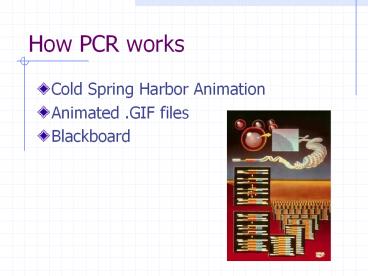How PCR works PowerPoint PPT Presentation
1 / 20
Title: How PCR works
1
How PCR works
- Cold Spring Harbor Animation
- Animated .GIF files
- Blackboard
2
Review The structure of DNA
Unzipping
Antiparallel Strands
3
How PCR works
- Cold Spring Harbor Animation
- PCR.EXE
4
How PCR works
- Animated .GIF 1
5
How PCR works
- Animated .GIF 2
6
How PCR works
- Blackboard
- (Dave attempts to draw this out!)
7
PCR Reaction Components
- Water
- Buffer
- DNA template
- Primers
- Nucleotides
- Mg ions
- DNA Polymerase
8
PCR Reaction Water
- Water
- The medium for all other components.
9
PCR Reaction Buffer
- Water
- Buffer
- Stabilizes the DNA polymerase, DNA, and
nucleotides - 500 mM KCl
- 100 mM Tris-HCl, pH 8.3
- Triton X-100 or Tween
10
PCR Reaction Template DNA
- Water
- Buffer
- DNA template
- Contains region to be amplified
- Any DNA desired
- Purity not required
- Should be free of polymerase inhibitors
11
PCR Reaction Primers
- Water
- Buffer
- DNA template
- Primers
- Specific for ends of amplified region
- Forward and Reverse
- Annealing temps should be known
- Depends on primer length, GC content, etc.
- Length 15-30 nt
- Conc 0.1 1.0 uM (pMol/ul)
12
PCR Reaction Nucleotides
- Water
- Buffer
- DNA template
- Primers
- Nucleotides
- Added to the growing chain
- Activated NTPs
- dATP, dGTP, dCTP, dTTP
- Stored at 10mM, pH 7.0
- Add to 20-200 uM in assay
13
PCR Reaction Magnesium
- Water
- Buffer
- DNA template
- Primers
- Nucleotides
- Mg ions
- Essential co-factor of DNA polymerase
- Too little Enzyme wont work.
- Stabilizes the DNA double-helix
- Too much DNA extra stable, non-specific
priming, band smearing - Used at 0.5 to 3.5 uM in the assay
14
PCR Reaction Polymerase
- Water
- Buffer
- DNA template
- Primers
- Nucleotides
- Mg ions
- DNA Polymerase
- The enzyme that does the extension
- TAQ or similar
- Heat-stable
- Approx 1 U / rxn
15
PCR Reaction Components
- Water
- Buffer
- DNA template
- Primers
- Nucleotides
- Mg ions
- DNA Polymerase
16
A Typical PCR Reaction
Sterile Water 38.0 ul 10X PCR Buffer
5.0 ul MgCl2 (50mM) 2.5 ul dNTPs
(10mM each) 1.0 ul PrimerFWD (25 pmol/ul) 1.0
ul PrimerREV 1.0 ul DNA Polymerase
0.5 ul DNA Template 1.0 ul Total
Volume 50.0 ul
17
A Simpler PCR Reaction
Sterile Water 38.0 ul 10X PCR Buffer
5.0 ul MgCl2 (50mM) 2.5 ul dNTPs
(10mM each) 1.0 ul PrimerFWD (25 pmol/ul) 1.0
ul PrimerREV 1.0 ul DNA Polymerase
0.5 ul DNA Template 1.0 ul Total
Volume 50.0 ul
PREMIX 24.0 ul Buffer MgCl2
dNTPs DNA Polymerase Enhancers
Sterile Water Primers FWDRev 1.0 ul DNA
Template 25.0 ul Total Volume
50.0 ul
PREMIXES CAN REDUCE THE NUMBER OF ITEMS ADDED TO
THE MIX
18
Using a PCR Mastermix
Component 1X 20X Sterile
Water 38.0 ul 760 ul 10X PCR Buffer
5.0 ul 100 ul MgCl2 (50mM)
2.5 ul 50 ul dNTPs (10mM each) 1.0 ul
20 ul PrimerFWD (25 pmol/ul) 1.0 ul 20
ul PrimerREV 1.0 ul 20 ul DNA
Polymerase 0.5 ul 10 ul DNA
Template 1.0 ul -- Total Volume
50.0 ul 980 ul
Aliquot 49 ul
Add DNA as last step
19
Typical Thermal Cycler Conditions
1. Initial Denaturation 95 C 4 min 2. DNA
Denaturation 95 C 1 min 3. Primer
Annealing 65 C 1 min 4. Primer Extension
72 C 1 min 5. Go to step 2, repeat 29
more times 6. Hold at 4 C 7. End
20
End of PCR Introduction
Lets plan out the GMO kit reactions and set them
up!

